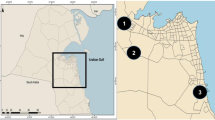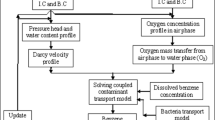Abstract
The release and transport of benzene in coastal aquifers were investigated in the present study. Numerical simulations were implemented using the SEAM3D, coupled with GMS, to study the behavior of benzene in the subsurface of tidally influenced beaches. The transport and fate of the benzene plume were simulated, considering advection, dispersion, sorption, biodegradation, and dissolution on the beach. Different tide amplitudes, aquifer characteristics, and pollutant release locations were studied. It was found that the tide amplitude, hydraulic conductivity, and longitudinal dispersivity were the primary factors affecting the fate and transport of benzene. The tidal amplitude influenced the transport speed and percentage of biodegradation of benzene plume in the beach. A high tidal range reduced the spreading area and enhanced the rate of benzene biodegradation. Hydraulic conductivity had an impact on plume residence time and the percentage of contaminant biodegradation. Lower hydraulic conductivity induced longer residence time in each beach portion and a higher percentage of biodegradation on the beach. The plume dispersed and the concentration decreased due to high longitudinal dispersivity. The results can be used to support future risk assessment and management for the shorelines impacted by spill and leaking accidents. Modeling the heterogeneous beach aquifer subjected to tides can also be further explored in the future study.

Similar content being viewed by others
References
Anderson M P, Woessner W W, Hunt R J (2015). Applied groundwater modeling: Simulation of flow and advective transport, 2nd ed. New York: Elsevier
Asif Z, Chen Z (2020). A life cycle based air quality modeling and decision support system (LCAQMS) for sustainable mining management. Journal of Environmental Informatics, 35(2): 103–117
Atlas R M, Hazen T C (2011). Oil biodegradation and bioremediation: A tale of the two worst spills in US history. Environmental Science & Technology, 45(16): 6709–6715
Babamiri O, Vanaei A, Guo X, Wu P, Richter A, Ng K T W (2021). Numerical simulation of water quality and self-purification in a mountainous river using QUAL2KW. Journal of Environmental Informatics, 37(1): 26–35
Bailey J, Ollis D (1986). Biochemical engineering fundamentals. New York: McGraw-Hill
Bear J, Cheng A H D(2010). Modeling groundwater flow and contaminant transport (Vol. 23). Springer Science & Business Media
Bhosale D, Kumar C (2002) Simulation of seawater intrusion in Ernakulam coast. In: Proceedings of International Conference on Hydrology and Watershed Management, Hyderabad, 390–399
Bi H, An C, Chen X, Owens E, Lee K (2020). Investigation into the oil removal from sand using a surface washing agent under different environmental conditions. Journal of Environmental Management, 275: 111232
Boufadel M C, Geng X, Short J (2016). Bioremediation of the Exxon Valdez oil in Prince William sound beaches. Marine Pollution Bulletin, 113(1–2): 156–164
Boufadel M C, Suidan M T, Venosa A D (1999). A numerical model for density-and-viscosity-dependent flows in two-dimensional variably saturated porous media. Journal of Contaminant Hydrology, 37(1–2): 1–20
Boufadel M C, Suidan M T, Venosa A D (2006). Tracer studies in laboratory beach simulating tidal influences. Journal of Environmental Engineering, 132(6): 616–623
Brock T D, Madigan M T, Martinko, J M, Parker J (2003). Biology of microorganisms, 10th ed. New Jersey: Prentice Hall
Brovelli A, Mao X, Barry D (2007). Numerical modeling of tidal influence on density-dependent contaminant transport. Water Resources Research, 43(10): W10426
Chen Y M, Abriola L M, Alvarez P J, Anid P J, Vogel T M (1992). Modeling transport and biodegradation of benzene and toluene in sandy aquifer material: Comparisons with experimental measurements. Water Resources Research, 28(7): 1833–1847
Chen Z K, An C, Boufadel M C, Owens E, Chen Z, Lee K, Cao Y, Cai M (2020). Use of surface-washing agents for the treatment of oiled shorelines: Research advancements, technical applications and future challenges. Chemical Engineering Journal, 391: 123565
Colombani N, Mastrocicco M, Prommer H, Sbarbati C, Petitta M (2015). Fate of arsenic, phosphate and ammonium plumes in a coastal aquifer affected by saltwater intrusion. Journal of Contaminant Hydrology, 179: 116–131
El-Kadi A I (2001). Modeling hydrocarbon biodegradation in tidal aquifers with water-saturation and heat inhibition effects. Journal of Contaminant Hydrology, 51(1–2): 97–125
Essaid H I, Bekins B A, Godsy E M, Warren E, Baedecker M J, Cozzarelli I M (1995). Simulation of aerobic and anaerobic biodegradation processes at a crude oil spill site. Water Resources Research, 31(12): 3309–3327
Essaid H I, Cozzarelli I M, Eganhouse R P, Herkelrath W N, Bekins B A, Delin G N (2003). Inverse modeling of BTEX dissolution and biodegradation at the Bemidji, MN crude-oil spill site. Journal of Contaminant Hydrology, 67(1–4): 269–299
Geng X, Boufadel M C, Cui F (2017). Numerical modeling of subsurface release and fate of benzene and toluene in coastal aquifers subjected to tides. Journal of Hydrology (Amsterdam), 551: 793–803
Geng X, Boufadel M C, Lee K, Abrams S, Suidan M (2015). Biodegradation of subsurface oil in a tidally influenced sand beach: Impact of hydraulics and interaction with pore water chemistry. Water Resources Research, 51(5): 3193–3218
Geng X, Boufadel MC, Lee K, An C (2020a). Characterization of pore water flow in 3-D heterogeneous permeability fields. Geophys Res Lett, 47(3): e2019GL086879
Geng X, Michael HA, Boufadel MC, Molz FJ, Gerges F, Lee K (2020b) Heterogeneity affects intertidal flow topology in coastal beach aquifers. Geophys Res Lett, 47(17): e2020GL089612
He L, Li Y, Zhu F, Sun X, Herrmann H, Schaefer T, Zhang Q, Wang S (2020). Insight into the mechanism of the OH-induced reaction of ketoprofen: A combined DFT simulation and experimental study. Journal of Environmental Informatics, 35(2): 128–137
Heiss J (2011). Intertidal mixing zone dynamics and swash induced infiltration in a sandy beach aquifer, Cape Henlopen, Delaware. Dissertation for the Ph. D Degree Delaware: University of Delaware
Heiss J, Michael H A (2014). Saltwater-freshwater mixing dynamics in a sandy beach aquifer over tidal, spring-neap, and seasonal cycles. Water Resources Research, 50(8): 6747–6766
Jiang Y, Xi B, Li R, Li M, Xu Z, Yang Y, Gao S (2019). Advances in Fe(III) bioreduction and its application prospect for groundwater remediation: A review. Frontiers of Environmental Science & Engineering, 13(6): 89
Khaska M, Le Gal La Salle C, Lancelot J, team A S T E R, Mohamad A, Verdoux P, Noret A, Simler R (2013). Origin of groundwater salinity (current seawater vs. saline deep water) in a coastal karst aquifer based on Sr and Cl isotopes. Case study of the La Clape massif (southern France). Applied Geochemistry, 37: 212–227
Kheirandish M, Rahimi H, Kamaliardakani M, Salim R (2020). Obtaining the effect of sewage network on groundwater quality using MT3DMS code: Case study on Bojnourd plain. Groundwater for Sustainable Development, 11: 100439
Lathashri U, Mahesha A (2016). Predictive simulation of seawater intrusion in a tropical coastal aquifer. Journal of Environmental Engineering, 142(12): D4015001
Leahy J G, Colwell R R (1990). Microbial degradation of hydrocarbons in the environment. Microbiology and Molecular Biology Reviews, 54(3): 305–315
Lee K, Boufadel M C, Chen B, Foght J, Hodson P, Swanson S, Venosa A (2015). Expert panel report on the behaviour and environmental impacts of crude oil released into aqueous environments. Royal Society of Canada, Ottawa: ON
Li C, Yan L, Li Y, Zhang D, Bao M, Dong L (2021). TiO2@palygorskite composite for the efficient remediation of oil spills via a dispersion-photodegradation synergy. Frontiers of Environmental Science & Engineering, 15(4): 72
Li H, Boufadel M C (2010). Long-term persistence of oil from the Exxon Valdez spill in two-layer beaches. Nature Geoscience, 3(2): 96–99
Liu Y, Jiao J J, Luo X (2016). Effects of inland water level oscillation on groundwater dynamics and land-sourced solute transport in a coastal aquifer. Coastal Engineering, 114: 347–360
Liu Z, Liu J, Zhu Q, Wu W (2012). The weathering of oil after the Deepwater Horizon oil spill: Insights from the chemical composition of the oil from the sea surface, salt marshes and sediments. Environmental Research Letters, 7(3): 035302
Lu G, Clement T P, Zheng C, Wiedemeier T H (1999). Natural attenuation of BTEX compounds: Model development and field-scale application. Ground Water, 37(5): 707–717
Mehl S W, Hill M C (2001). User guide to the Link-AMG (LMG) package for solving matrix equations using an algebraic multigrid solver. U.S. Geological Survey Open File Report 01–177. Reston. USGS: Virginia
Ordieres-Meré J, Ouarzazi J, El Johra B, Gong B (2020). Predicting ground level ozone in Marrakesh by machine-learning techniques. Journal of Environmental Informatics, 36(2): 93–106
Ramakrishnan A, Blaney L, Kao J, Tyagi R D, Zhang T C, Surampalli R Y (2015). Emerging contaminants in landfill leachate and their sustainable management. Environmental Earth Sciences, 73(3): 1357–1368
Robinson C, Gibbes B, Carey H, Li L (2007). Salt-freshwater dynamics in a subterranean estuary over a spring-neap tidal cycle. Journal of Geophysical Research, 112(C9): C09007
Santos F, DeCastro M, Gómez-Gesteira M, Álvarez I (2012). Differences in coastal and oceanic SST warming rates along the Canary upwelling ecosystem from 1982 to 2010. Continental Shelf Research, 47: 1–6
Sbarbati C, Colombani N, Mastrocicco M, Aravena R, Petitta M (2015). Performance of different assessment methods to evaluate contaminant sources and fate in a coastal aquifer. Environmental Science and Pollution Research International, 22(20): 15536–15548
Schulze-Makuch D (2005). Longitudinal dispersivity data and implications for scaling behavior. Ground Water, 43(3): 443–456
Shrestha N, Wang J (2020). Water quality management of a cold climate region watershed in changing climate. Journal of Environmental Informatics, 35(1): 56–80
Torlapati J, Boufadel M C (2014). Evaluation of the biodegradation of Alaska North Slope oil in microcosms using the biodegradation model BIOB. Frontiers in Microbiology, 5: 212
Uraizee F A, Venosa A D, Suidan M T (1997). A model for diffusion controlled bioavailability of crude oil components. Biodegradation, 8(5): 287–296
Wang Z, An C, Chen X, Lee K, Zhang B, Feng Q (2021). Disposable masks release microplastics to the aqueous environment with exacerbation by natural weathering. Journal of Hazardous Materials, 417: 126036
Widdowson M A, Molz F J, Benefield L D (1988). A numerical transport model for oxygen-and nitrate-based respiration linked to substrate and nutrient availability in porous media. Water Resources Research, 24(9): 1553–1565
Xu Z, Chai J, Wu Y, Qin R (2015). Transport and biodegradation modeling of gasoline spills in soil-aquifer system. Environmental Earth Sciences, 74(4): 2871–2882
Zhai A, Ding X, Liu L, Zhu Q, Huang G (2020a). Total phosphorus accident pollution and emergency response study based on geographic information system in Three Gorges Reservoir area. Frontiers of Environmental Science & Engineering, 14(3): 46
Zhai A, Ding X, Zhao Y, Xiao W, Lu B (2020b). Improvement of instantaneous point source model for simulating radionuclide diffusion in oceans under nuclear power plant accidents. Journal of Environmental Informatics, 36(2): 133–145
Zhao Y, Lin L, Hong M (2019). Nitrobenzene contamination of groundwater in a petrochemical industry site. Frontiers of Environmental Science & Engineering, 13(2): 29
Acknowledgements
This research was supported by the Multi-partner Research Initiative of Fisheries and Oceans Canada and the Natural Sciences and Engineering Research Council of Canada. The authors are particularly thankful to the comments and suggestions from international experts of oil spill control and response. The authors are also grateful to Huifang Bi, the editor and the anonymous reviewers for their insightful comments and suggestions.
Author information
Authors and Affiliations
Corresponding author
Additional information
Highlights
• An approach for assessing the transport of benzene on the beach was proposed.
• The behavior of benzene in the subsurface of the beach was impacted by tide.
• Tidal amplitude influenced the travel speed and the benzene biodegradation.
• Hydraulic conductivity had the impact on plume residence time and biodegradation.
• Plume dispersed and concentration decreased due to high longitudinal dispersivity.
Rights and permissions
About this article
Cite this article
Kheirandish, M., An, C., Chen, Z. et al. Numerical simulation of benzene transport in shoreline groundwater affected by tides under different conditions. Front. Environ. Sci. Eng. 16, 61 (2022). https://doi.org/10.1007/s11783-022-1540-9
Received:
Revised:
Accepted:
Published:
DOI: https://doi.org/10.1007/s11783-022-1540-9




